|
 | Add on planes - Planes |  |
All
Virtual Sailor and Micro Flight add-ons install and run on Vehicle Simulator
| Douglas DC-3 |
Author: Victor
Egorov |
The Douglas DC-3 is a fixed-wing, propeller-driven aircraft which
revolutionized air transport in the 1930s and 1940s, and is generally regarded as one of the most significant transport aircraft ever made.
This amazing plane was created by Victor
Egorov |
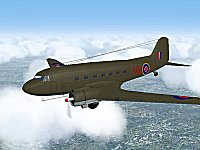 |
|
Download
( 0.5 MB ) |
|
|
| Me-109E-3 |
Author: Victor
Egorov |
The Me-109 was the best known and most produced
German fighter of World War II. It was the
backbone of the German fighter command and ruled
the skies over Europe from 1939 to 1941, as
Hitler spread his empire over the continent. The
Me-109s earned the respect of Germany's enemies
in every theater of conflict and were greatly
feared by Allied bomber crews during the later
half of the war. Designed by Willie Messerschmitt
in 1934, the Bf 109 was first flown in September
1935.
The Me-109 was a formidable opponent for the
early marks of Spitfire; its low speed handling
qualities were excellent and its rate of climb
matched the Spitfire. Moreover, it had a higher
service ceiling and it had one other major
advantage - fuel injection. This allowed the
Me-109's power plant to run flawlessly regardless
of the aircraft's attitude, unlike the
Rolls-Royce engines of early Spitfires, which cut
out at the slightest suggestion of negative G.
The Messerschmitt had its vices, too: the cockpit
was very small, the heavily framed canopy
restricted the pilot's field of view and the
plane's narrow undercarriage made it extremely
prone to ground accidents. Many of the 33,000
Me-109s produced were lost in ground accidents.
This amazing plane was created by Victor
Egorov |
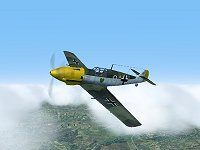 |
|
Download
( 0.5 MB ) |
|
|
| Spitfire Mk.1B |
Author: Victor
Egorov |
The Spitfire was a low-wing monoplane that was
first flown in 1936 and was first put into
service with the Royal
Air Force in 1938.
It was modified continuously
throughout the war to serve in a variety of
roles:
fighter (with
notable success at high altitudes),
fighter-bomber, and photoreconnaissance plane.
The version that entered
active service in 1938 had a top speed of about
360 miles (580 km) per hour and an armament of
eight .303-inch
machine guns.
The Spitfire XIV, one of the last
models of the war, had a ceiling of 40,000 feet
(12,200 m) and a
top speed of 440 miles (710 km) per hour.
(enc.
Britannica)
This plane is the most impressive fighter built
for Micro-Flight, it is an essential download for
any user ! This amazing plane was
created by Victor
Egorov
|
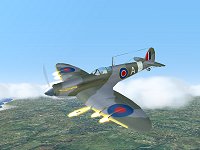 |
|
Download
( 0.5 MB ) |
|
|
| Sopwith Camel 1916. |
Author:
Victor Egorov |
The Sopwith Camel was a
British World War I single-seat fighter aircraft.
The Sopwith Camel was first built in 1916 by the
Sopwith Aviation Company. Approximately 6,000
Sopwith Camels were produced.
It featured a 150 h.p. Gnome 9 cylinder rotary
engine, and it was armed with two Vickers .303
inch machine guns mounted in front of the
cockpit, firing forward through the propeller
disc. It was capable of reaching a speed of 115
mph. There was a fairing surrounding the gun
installation which created a hump. It was this
hump that led to the aircraft acquiring the name
Camel.
This fantastic plane has been made by Victor Egorov |
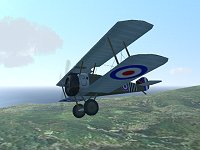 |
| Download ( 0.4
MB ) |
|
|
| US Navy N2S3 Stearman |
Author: Brian
Ford |
The N2S3 was one of the US Navy versions of the famous Boeing Stearman PT-17.
This beautiful plane was created by Brian
Ford |
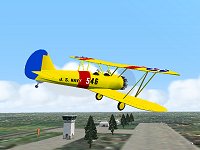
|
| Download (
0.5 MB ) |
|
|
| Fairey Swordfish |
Author:
Mathias
Pommerien and Alessandro Biagi |
The biplane was clearly an
obsolete concept by the beginning of the Second
World War; and so it is somewhat surprising that
one biplane, the British Fairey
"Swordfish" torpedo bomber, proved to
be a highly effective weapon. The Swordfish
remained in first line-service through the entire
war in Europe.
Fairey followed the Swordfish with two more
torpedo-bombers, the "Albacore" and the
"Barracuda". Neither achieved the
prominence of the Swordfish, and in fact the
Swordfish outlived the Albacore in service. This
document provides a short history of the
Swordfish, Albacore, and Barracuda.
This beautiful plane was created by Mathias
Pommerien and Alessandro Biagi (c) |

|
| Download ( 1.5
MB ) |
|
|
| 1931 Laird "Super Solution" |
Author:
Jeffery S. Koppe |
The 1930s are known as the 'Golden Age of
Aviation'. Nothing is more symbolic of that age
than the sleek racing planes that pushed aviation
technology to its limits. The Super Solution was
contender through and through. Built for speed,
distance and endurance, this sleek Wasp powered
biplane proved its mettle while piloted by Jimmy
Doolittle in the 1931 Bendix and Thompson Races.
Doolittle easily won the cross-country Bendix,
shaving more than an hour off the previous record
(though much of the credit must go to
Doolilttle's unerring instrument flying--an
unheard of talent in the early 30s). A few days
later he was forced to drop out of the Thompson
pylon race due to engine trouble giving the
victory to the Granville Brother's Model Z.
Doolittle planned to fly the Super Solution in
the 1932 Thompson but a crash just weeks before
the race ended the dream. Instead, Doolittle flew
the GeeBee R1 to victory. The Super Solution
became a show plane, paraded around the country
doing air shows and minor races, passed from hand
to hand.
Parts of it are still in existance at
the National Aviation Museum and a few other
museums. There is a replica at the Air Adventure
Museum in Oshkosh WI, and a flying replica has
been built by Jim Moss at a small airfield near
Puyallup, WA.This beautiful plane was
created by
Jeffery
S. Koppe
See more of Jeff's work at
Flying
Machines and Port of Call
|
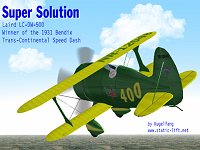 |
|
Download
( 0.65 MB ) |
|
|
| Gee Bee R1 |
Author:
H.Richard SantaColoma |
Designed by the Granville Brothers Aircraft Co,
with
Howell W. Miller as Chief Engineer. The plane was
designed specifically for the Thompson Trophy
Race
at the 1932 Cleveland Air Races. The similar R2
was
built for the Bendix Trophy race at Cleveland the
same year.
On September 5th, 1932, the famous Jimmy
Doolittle piloted
the R1 to win the Thompson Trophy with an average
252.686 MPH.
Power: 800 H.P. Pratt & Whitney R1340
"Wasp"
Wing Span: 25 feet
Empty weight: 1,840 lbs.
Fuel capacity: 160 gallons
This beutiful plane was created by
H.Richard SantaColoma |
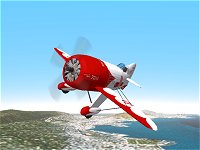 |
|
Download
( 0.45 MB ) |
|
|
| The Soviet experimental sports plane BOK-5 (1937). |
Author:
Victor Egorov |
|
BOK-5 was full aerobatics sport plane ( was investigated as
perspective "flying wing" fighter ). Vladimir A.
Chizhevskii was a Director of the BOK ( buro
osobikh konstruktsii ) OKB for experemental
aircraft. This team, concentrated mostly on
unusial and record-setting designs, included also
deputy N. N. Kashtanov, constructors Kamov, Sukhoi, Skrzhinskii,
Cheryanovskii, Krichyevskii.
Opened 1 January, 1931. BOK merged into Sukhoi
OKB in 1940 after arrest of Chizhyevskii.
Chizhevskii joined Tupolev in 1949
This fantastic plane has been made by
Victor Egorov and includes all
internal and external detailes.
|

Screenshot 2 |
|
Download
( 0.25 MB ) |
|
|
| Airco D.H.2 |
Author:
Keith L. Quinney |
Designed by Geoffery de Haviland, the DH2 did more than any other allied
plane to overcome the Fokker threat in the spring
of 1916.
The pusher design meant that a gun could be
mounted in the nose without an interrupter gear
and it proved to be a rugged and reliable
aircraft.
By the autumn of 1916 the DH2 was overtaken by
more modern designs and relegated to home defence
and training.
This
beutiful plane was modelled by
Keith
L. Quinney
|
 |
|
Download
( 0.25 MB ) |
|
|
| Handley-Page
HP- 42 Hannibal |
Author:
H.Richard
SantaColoma |
There were only 8 of the HP42's ever built, but
in their 16 year life, carried over 100,000
passengers. The first was launched in November of
1930, and earned an immediate reputation for
comfort, quietness and reliability. They were
operated by Imperial Airways for both thier
European and Eastern routes.
This is the first passeneger plane built for
Micro-Flight and also the most detailed, it is
unique because it allows the user to be a
passenger and a pilot and feel the plane from any
perspective.
This beutiful plane was created by
H.Richard
SantaColoma |
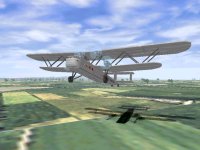
Screenshot 2
Screenshot 3
Screenshot 4 |
|
Download
( 0.6 MB ) |
|
|
| Albatros
D.II 1916 |
Author:
Jeffery
S. Koppe |
The streamlined Albatros D.II fighter entered
service in August 1916 equiped with the 160hp
Daimler D.III six cylinder water-cooled engine.
It also carried twin Spandau 7.92 mm machine
guns.
About 60 D.I's were built before production
stopped in favor of the D.II.
The D.I and D.II were the forerunners of the
Albatros D.III which allowed Germany to regain
control of the air from the Allied nations in
World War I.
Two hundred and fourteen Albatros D.II fighters
were recorded at the Front in January 1917 and
many renowned aces scored while flying them.
This beautiful plane was created by
Jeffery
S. Koppe |
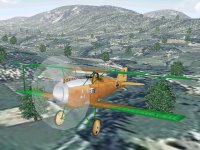
|
|
Download (
0.5 MB ) |
|
|
| Hanriot
HD.1, 1917 |
Author:
Jeffery
S. Koppe |
A French design, the Hanriot HD.1 found favor
with the Italian and Belgian Air Services during
WWI.
A fast, nimble machine with a good rate of climb,
it was lightly armed with a single machine gun.
These planes were powered by either a 110 hp or a
130 hp LeRhone rotary engine.
By the end of WWI, all but a few of the Italian
pursuit squadriglia were supplied with the
Hanriot HD.1.
They continued in active service well into the
1930's.
This beautiful plane was created by
Jeffery
S. Koppe |
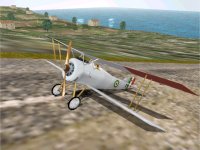
|
|
Download ( 0.5 MB ) |
|
|
| Nieuport 11
"Bebe", 1916 |
Author:
Jeffery
S. Koppe |
No other plane typifies the French Air Service as
well as the Nieuport 11.
Originally designed as a contestant for the 1914
Gordon Bennett Trophy Race, the Bebe saw service
with almost every Allied nation and all European
fronts of WWI.
It was this plane that enabled the Allies to end
the "Fokker Scourge".
The "Fokker Scourge" was brought about
by the overwhelming advantage the Germans gained
by arming the Fokker Eindecker with an interupter
gear which allowed a machine gun to fire through
the arc of the propellor.
However, the single gun of the Bebe was
inconveniently mounted above the top wing, firing
over the spinning propellor.
None-the-less, the Nieuport 11's excellent flying
characteristics nearly drove the Germans from the
skies.
This beautiful plane was created by
Jeffery
S. Koppe |
 |
|
Download
( 0.5 MB ) |
|
|
| Phoenix
D.II, 1918 |
Author:
Jeffery
S. Koppe |
The Austro-Hungarian Empire, though hampered by
poor industrial capabilities, could design
competitive fighter planes.
The Phoenix D.I, D.II, and D.III were capable,
though not superb, planes.
The D.II has been described as fast and stable
but with a somewhat poor rate of climb.
Powered by a 200 hp Hiero engine, the planes were
armed with twin Schwarzlose machine guns usually
buried in the fuselage on either side of the
engine. Ph?nix D series fighters were the primary
scout planes of both the Austrian Army and Navy
in the last year of WWI. They were frequently
modified in the field and are pictured with a
bewildering number of different radiators and gun
arrangements.
This particular plane, serial no. 422.14, was
flown by Feldwebel Alexander Kasza of Flik 55j in
June 1918.
This beautiful plane was created by
Jeffery
S. Koppe |
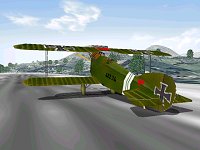 |
|
Download
( 0.5 MB ) |
|
|
| Wright EX,
1911 |
Author:
Jeffery
S. Koppe |
Wright
EX, 1911
The Wright EX was a derivation of the 2nd
generation of Wright planes, the Model B. The
Model B differed from the Model A by having the
elevator moved to the rear of the plane, two
small vanes attached to the fore struts for
stability, and most importantly of all, the
addition of wheels to the landing skids. The EX
and its sister the "Baby Grand" were
smaller version of the two seater Model B and
were specifically designed for racing. A number
of both of these planes were built but the EX won
eternal fame in the annuals of aviation when Cal
Rodgers was the first person to fly from coast to
coast across the USA with his EX, the Vin Fiz.
This beautiful plane was created by
Jeffery
S. Koppe
See more of Jeff's fantastic
work at
Flying
Machines and Port of Call |
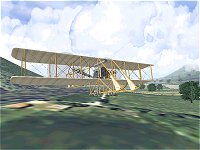 |
|
Download
( 0.5 MB ) |
|
|
| Sopwith
Triplane |
Author:
Keith
L. Quinney |
Sopwith
Triplane 1917
Only about 140 of these aircraft were built and
saw service, mainly on the western front flown by
the Royal Naval Air Service. They were however
very effective and spawned a number
of copies from other manufacturers, most notably
Fokker. Powered by a 130 Hp rotary engine, with a
span of 26 ft.6 in. a length of 18 ft.10
in.weighing
1,541 lb. at take off, they had a max. speed of
113mph at 6000 ft.
This beutiful plane was modelled by
Keith
L. Quinney
See
Keith's interesting website "low cost pedals
and throttle" |
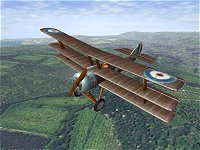 |
|
Download
( 0.5 MB ) |
|
|
| Fokker
DR-I Triplane |
Author:
Keith
L. Quinney |
Fokker
DR-I Triplane 1917/1918
Designed for the Fokker company, by Reinhold Platz, in response to the Sopwith Triplane's
success, it was flown by some of the top German
aces including Werner Voss and Manfred Von Richthofen. It had a short but notable service
career marred by doubts over the wing designs
strength.
Specifications:
Wing span: 23 ft 7 3/8 in (7.19 m) , Wing Area
(inc. Axle): 201.5 sq ft (18.66 sq m) , Length:
18 ft 11 1/8 in (5.77 m) , Height: 9 ft 8 1/8 in
(2.95 m) , Gross Weight: 1,289 lbs (584 kgs) ,
Maximum Speed: 115 mph (185 km/h) (at) sea level,
Service Ceiling: 19,600 ft (5,974 m) , Engine:
One Oberursel 110 hp (82 kw) 9-cylinder rotary, aircooled, Armament: Twin Spandau guns
This beutiful plane was modelled by
Keith
L. Quinney
See
Keith's interesting website "low cost pedals
and throttle" |
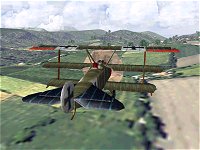 |
|
Download
( 0.5 MB ) |
|
|
| Sopwith
Pup |
Author:
Keith
L. Quinney |
Sopwith
Pup
Designed by Herbert Smith on the basis of the
personal aircraft of Harry Hawker the result
looked like a smaller version of the 11/2
Strutter then in production, and so was nicknamed
the pup.
Renowned for its good performance for a 80 Hp
engine and its eccelent flying characteristics,
it served widely in many theatres of war and
subsequently as a trainer.
Specifications:
80 Hp rotary engine , Span 8.08m , Length 8.89m ,
Weight 550 kg , Max speed 111 Mph , Ceiling
5330m.
This beutiful plane was modelled by
Keith
L. Quinney
See
Keith's interesting website "low cost pedals
and throttle" |
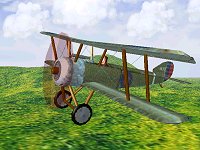 |
|
Download
( 0.25 MB ) |
|
|
| SE5a
biplane |
Author:
Keith
L. Quinney |
SE5a
1917/18
The most successful of all the Royal Aircraft
Factory's planes, the S.E.5a could out-climb and
out-dive the Sopwith Camel although slightly less manoeuvrable.
Introduced in April 1917 in France it quickly
proved it's worth and was to become the mount of
many famous pliots including Albert Ball and
"Mick" Mannock.
A total of over 5000 machines were produced,
fewer than planned due to problems with the early Hispano-Suiza engines.
Specification :-Engine: One 200 h.p. Wolseley
W.4a Viper water-cooled Vee-type. Span: 26 ft. 7
in. (8.11 rn). Length: 20 ft.11 in. (6.38 rn).
Height: 9 ft. 6 in. (2.89 rn). Take-off weight:
1,988 lb. (902 kg.). Maximum speed 120 mph. (193
km/hr.) at 15,000 ft. (4,572 rn). Operational
ceiling: 19,500 ft. (5,944 rn). Endurance: 3 hr.
This beutiful plane was modelled by
Keith
L. Quinney |
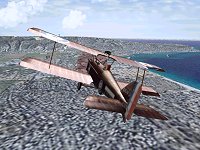 |
|
Download
( 0.5 MB ) |
|
|
| Yakovlev
AIR-7 (Ya-7) record aircraft |
Author:
Victor
Egorov |
Two seat low-wing monoplane built for record
speed in USSR.
Construction started in April 1932. Aircraft was
ready at the end of a Summer 1932. Same year (
November 19 ) speed 325km/h ( 175 kts ) was
demonstrated, and on Spring 1933 - 332km/h ( 179
kts ).
Flights continued until 1934, when aileron broke
off in flight due to flatter ( then almost
unknown and not understood).
Test-pilot Yu.I.Piontkovskij managed to land on
unprepared terrain ( tiny strip of land in the
freight yard clattered with firewood and all sort
of rubbish ).
Since AIR-7 fulfilled its goal ( to demonstrate
high speed ), it was not restored.
This fantastic plane has been made by
Victor
Egorov |
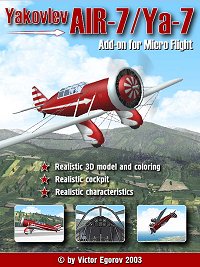 |
|
Download
( 0.4 MB ) |
|
|
|
|
